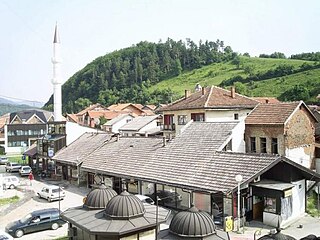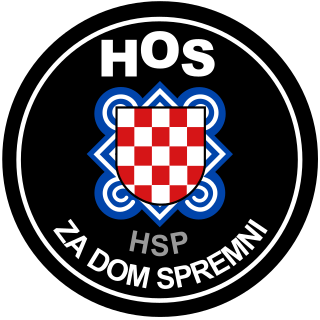
Canton 10 or Herzeg-Bosnian Canton is one of the ten cantons of the Federation of Bosnia and Herzegovina, a political entity of Bosnia and Herzegovina. It is the largest canton by area and eighth by population. The local government seat is in Livno, while the assembly is in Tomislavgrad.

The Bosnian War was an international armed conflict that took place in Bosnia and Herzegovina between 1992 and 1995. The war is commonly seen as having started on 6 April 1992, following a number of earlier violent incidents. The war ended on 14 December 1995 when the Dayton accords were signed. The main belligerents were the forces of the Republic of Bosnia and Herzegovina, those of Republic of Herzeg-Bosnia and Republika Srpska, proto-states led and supplied by Croatia and Serbia, respectively.

Gornji Vakuf-Uskoplje is a town and municipality located in Central Bosnia Canton of the Federation of Bosnia and Herzegovina, an entity of Bosnia and Herzegovina.

Vareš is a town and municipality located in Zenica-Doboj Canton of the Federation of Bosnia and Herzegovina, an entity of Bosnia and Herzegovina. It is situated in central Bosnia and Herzegovina, and is famous for the local mining activities and production of iron. As of 2013, it has a population of 8,892 inhabitants, with 2,917 in the town itself.

Blaž Nikola Kraljević was a Bosnian Croat paramilitary leader who commanded the Croatian Defence Forces (HOS) during the Bosnian War. An immigrant to Australia, Kraljević joined the Croatian Revolutionary Brotherhood (HRB) upon his arrival there in 1967. During his return to Yugoslavia in January 1992 he was appointed by Dobroslav Paraga, leader of the Croatian Party of Rights (HSP), as leader of the HOS in Bosnia and Herzegovina.

The Croatian Defence Forces were the paramilitary arm of the Croatian Party of Rights (HSP) from 1991 to 1992, during the first stages of the Yugoslav wars. During the Croatian War of Independence, the HOS organized several early companies and participated in Croatia's defense. At the peak of the war in Croatia, the HOS was several battalions in size. The first HOS units were headed by Ante Paradžik, a HSP member who was killed by Croatian police in September 1991. After the November 1991 general mobilization in Croatia and the January 1992 cease-fire, the HOS was absorbed by the Croatian Army.

The Army of the Republic of Bosnia and Herzegovina, often referred to as Bosnian Army or Bosniak Army, was the military force of the Republic of Bosnia and Herzegovina. It was established by the government of the Republic of Bosnia and Herzegovina in 1992 following the outbreak of the Bosnian War.

Kupres is a town and municipality located in Canton 10 of the Federation of Bosnia and Herzegovina, an entity of Bosnia and Herzegovina. As of 2013, it has a population of 5,057 inhabitants, while the town of Kupres has a population of 2,883 inhabitants.

The Croatian Republic of Herzeg-Bosnia was first a geopolitical entity and then an unrecognized quasi-state in Bosnia and Herzegovina. It was proclaimed on 18 November 1991 under the name Croatian Community of Herzeg-Bosnia as a "political, cultural, economic and territorial whole" in the territory of Bosnia and Herzegovina, and abolished on 14 August 1996.

The Croatian Defence Council was the official military formation of the Croatian Republic of Herzeg-Bosnia, an unrecognized entity that existed in Bosnia and Herzegovina between 1991 and 1996. The HVO was the main military force of Croats of Bosnia and Herzegovina.
Operation Mistral 2, officially codenamed Operation Maestral 2, was a Croatian Army (HV) and Croatian Defence Council (HVO) offensive in western Bosnia and Herzegovina on 8–15 September 1995 as part of the Bosnian War. Its objective was to create a security buffer between Croatia and positions held by the Bosnian Serb Army of Republika Srpska (VRS). The operation also spearheaded a Herzeg-Croat led move to compromise the occupation of the largest Bosnian Serb-held city, Banja Luka, by capturing the towns of Jajce, Šipovo and Drvar. Thus jeopardizing the operations capacity of Banja Luka and ultimately leading to its recapture. The combined HV and HVO forces were under the overall command of HV Major General Ante Gotovina.

The Croat–Bosniak War was a conflict between the Republic of Bosnia and Herzegovina and the Republic of Herzeg-Bosnia, supported by Croatia, that lasted from 18 October 1992 to 23 February 1994. It is often referred to as a "war within a war" because it was part of the larger Bosnian War. In the beginning, the Army of the Republic of Bosnia and Herzegovina and the Croatian Defence Council fought together in an alliance against the Yugoslav People's Army (JNA) and the Army of Republika Srpska (VRS). By the end of 1992, however, tensions between Bosniaks and Bosnian Croats increased. The first armed incidents between them occurred in October 1992 in central Bosnia. The military alliance continued until early 1993, when it mostly fell apart and the two former allies engaged in open conflict.
Operation Corridor 92 was the largest operation conducted during the Bosnian War by the Army of Republika Srpska (VRS) against the forces of the Croatian Defence Council (HVO) and the Croatian Army (HV) in the Bosanska Posavina region of northern Bosnia and Herzegovina between 24 June and 6 October 1992. The objective of the offensive was to re-establish a road link between the city of Banja Luka in the west of the country and the eastern parts of the territory controlled by the Bosnian Serbs. The offensive was prompted by the capture of Derventa by the HV and the HVO – a move that blocked the single overland road between the VRS-controlled territories.
Operation Vrbas '92 was a military offensive undertaken by the Army of Republika Srpska in June–October 1992, during the Bosnian War. The goal of the operation was the destruction of a salient around the central Bosnian town of Jajce, which was held by the Croatian Defence Council and the Army of the Republic of Bosnia and Herzegovina. The intensity of fighting varied considerably and involved several major VRS offensive efforts interspersed by relative lulls in fighting. Jajce fell to the VRS on 29 October 1992, and the town's capture was followed by the destruction of all its mosques and Roman Catholic churches.

The Croat–Bosniak War was a conflict between the Republic of Bosnia and Herzegovina and the Croatian Community of Herzeg-Bosnia, supported by Croatia, that lasted from 19 June 1992 – 23 February 1994. The Croat-Bosniak War is often referred to as a "war within a war" because it was part of the larger Bosnian War.

The siege of Mostar was fought during the Bosnian War first in 1992 and then again later in 1993 to 1994. Initially lasting between April 1992 and June 1992, it involved the Croatian Defence Council (HVO) and the Army of the Republic of Bosnia and Herzegovina (ARBiH) fighting against the Serb-dominated Yugoslav People's Army (JNA) after Bosnia and Herzegovina declared its independence from Yugoslavia. That phase ended in June 1992 after the success of Operation Jackal, launched by the Croatian Army (HV) and HVO. As a result of the first siege around 90,000 residents of Mostar fled and numerous religious buildings, cultural institutions, and bridges were damaged or destroyed.

The Battle of Kupres was a battle of the Bosnian War, fought between the Army of the Republic of Bosnia and Herzegovina (ARBiH) and the Croatian Defence Council (HVO) on one side and the Army of Republika Srpska (VRS) on the other from 20 October to 3 November 1994. It marks the first tangible evidence of the Bosniak–Croat alliance set out in the Washington Agreement of March 1994, brokered by the United States to end the Croat–Bosniak War fought between the ARBiH and the HVO in Bosnia and Herzegovina. The ARBiH and the HVO were not coordinated at first, rather they launched separate operations aimed at capture of Kupres.
The Agreement on Friendship and Cooperation between Bosnia and Herzegovina and Croatia was signed by Alija Izetbegović, President of the Republic of Bosnia and Herzegovina, and Franjo Tuđman, President of the Republic of Croatia, in Zagreb on 21 July 1992 during the Bosnian and Croatian wars for independence from Yugoslavia. It established cooperation, albeit inharmonious, between the two and served as a basis for joint defense against Serb forces. It also placed the Croatian Defence Council (HVO) under the command of the Army of the Republic of Bosnia and Herzegovina (ARBiH).
Operation Southern Move was the final Croatian Army (HV) and Croatian Defence Council (HVO) offensive of the Bosnian War. It took place in western Bosnia and Herzegovina on 8–11 October 1995. Its goal was to help the Army of the Republic of Bosnia and Herzegovina (ARBiH) whose positions around the town of Ključ, captured by them during Operation Sana, were endangered by a counteroffensive by the Army of Republika Srpska (VRS). The objectives of Operation Southern Move included the capture of the town of Mrkonjić Grad and positions on the Manjača Mountain which would allow the HV and the HVO to directly threaten Banja Luka, the largest city controlled by Bosnian Serbs. Finally, the offensive was also aimed at capturing the Bočac Hydroelectric Power Station, the last significant source of electricity under VRS control in western Bosnia and Herzegovina. The combined HV and HVO forces were under the overall command of HV Major General Ante Gotovina.
The Battle of Bugojno was fought between forces of the Army of the Republic of Bosnia and Herzegovina (ARBiH) and the Croatian Defence Council (HVO) for control of the town and municipality of Bugojno in central Bosnia, from 18–28 July 1993. The area of Bugojno was under joint control of the ARBiH 307th Brigade and the HVO Eugen Kvaternik Brigade since the start of the Bosnian War. Violent incidents in Bugojno followed the escalation of the Croat-Bosniak War in adjacent municipalities throughout the 1st half of 1993. Bugojno was spared from fighting and the two local brigades were still formally allied by June 1993, at the time of an ARBiH offensive in central Bosnia.














